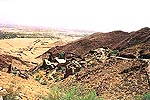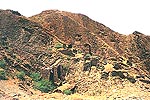The Vinaya text throws light on the architecture of the monastery. The
village is built on the ruins of the ancient town, the foundation walls
of which are still in a tolerably good formation.  As a proof, that it was in the past
occupied by the Buddhists and Hindu races, coins of those periods are
still found at the site. the monks constructed it for their convenience.
Spring water was supplied to them on hill tops; living quarters for
ventilators for light and alcoves for oil lamps were made in the walls.
From the description of Song Yun, a Chinese pilgrim, it appears that it
was on one of the four great cities lying along the important commercial
route to India. It was a well-fortified town with four gates outside the
northern one, on the mound known as Chajaka Dehri which was a
magnificent temple containing beautiful stone images covered in gold
leaves. Not far from the rocky defile of Khaperdra did Ashoka build the
eastern gate of the town outside of which existed a stupa and a
sangharama.
As a proof, that it was in the past
occupied by the Buddhists and Hindu races, coins of those periods are
still found at the site. the monks constructed it for their convenience.
Spring water was supplied to them on hill tops; living quarters for
ventilators for light and alcoves for oil lamps were made in the walls.
From the description of Song Yun, a Chinese pilgrim, it appears that it
was on one of the four great cities lying along the important commercial
route to India. It was a well-fortified town with four gates outside the
northern one, on the mound known as Chajaka Dehri which was a
magnificent temple containing beautiful stone images covered in gold
leaves. Not far from the rocky defile of Khaperdra did Ashoka build the
eastern gate of the town outside of which existed a stupa and a
sangharama.
The group of buildings unearthed after archeological excavations at
Takht-i-Bahi may include; the court of many Stupas, the monastery, the
main stupa, the assembly hall, the low-level chambers, the courtyard,
the court of three stupas, the wall of colossi and the secular building.
 In 1871, Sergeant Wilcher found
innumerable sculptures at Takht-i-Bahi. Some depicted stories from the
life of Buddha, while others more devotional in nature included the
Buddha and Bodhisattava. The Court of Stupas is sorrounded on three
sides by open alcoves or chapels. The excavators were of the view that
originally they contained single plaster statues of Buddha either
sitting or standing, dedicated in memory of holy men or donated by rich
pilgrims. The monastery on the north, was probably a double storied
structure consisting of an open court, ringged with cells, kitchens and
a refactory.
In 1871, Sergeant Wilcher found
innumerable sculptures at Takht-i-Bahi. Some depicted stories from the
life of Buddha, while others more devotional in nature included the
Buddha and Bodhisattava. The Court of Stupas is sorrounded on three
sides by open alcoves or chapels. The excavators were of the view that
originally they contained single plaster statues of Buddha either
sitting or standing, dedicated in memory of holy men or donated by rich
pilgrims. The monastery on the north, was probably a double storied
structure consisting of an open court, ringged with cells, kitchens and
a refactory.
A visit to Takht-i-Bahi is an informative experience particularly to those interested in archaeological excavations. Walking further, you will come accross the monestary court which was a residential area and as such a small number of sculptures were recovered. However, a beautiful emaciated Siddhartha in three parts was discovered. Likewise the other courts with Buddha's images in stucco are equally interesting and they were used either for meditation, meetings or storage. A truly majestic place!


